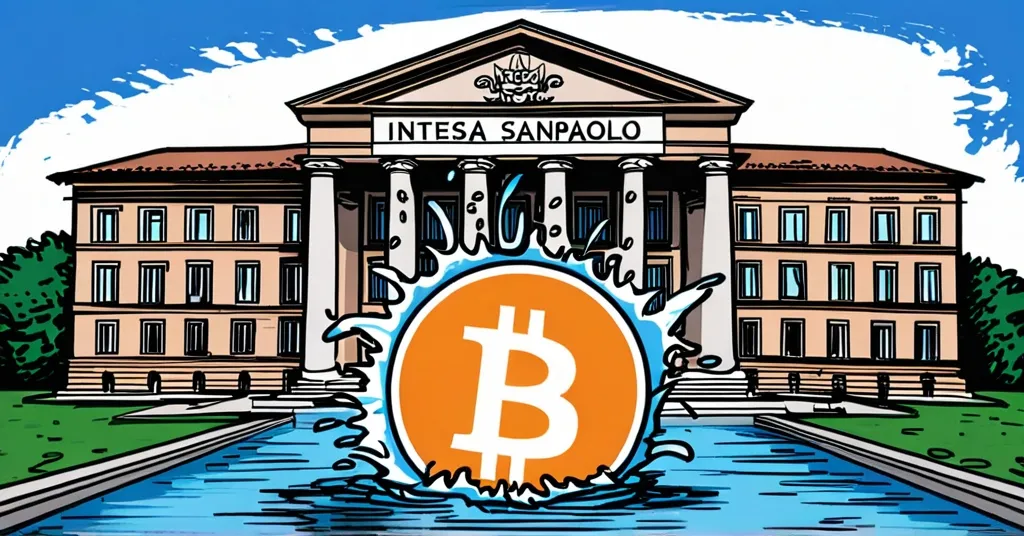Intesa Sanpaolo Buys $1M in Bitcoin: A First for Italian Banks

Intesa Sanpaolo Invests $1 Million in Bitcoin: A Milestone for Italian Finance
Intesa Sanpaolo, Italy’s largest banking group, has made a significant leap into the cryptocurrency arena by purchasing 11 Bitcoin worth around $1 million. This bold move marks the first time an Italian financial institution has directly invested in Bitcoin, signaling a notable shift in the traditional finance sector’s approach to digital assets.
- Intesa Sanpaolo invests $1 million in Bitcoin
- First Italian financial institution to directly buy Bitcoin
- Institutional interest influenced by U.S. and EU policy developments
The acquisition was confirmed by the bank’s press office following an internal email leak, highlighting Intesa Sanpaolo’s willingness to embrace the digital finance revolution. While the specific motives behind this purchase remain undisclosed, it aligns with a growing trend of institutional interest in Bitcoin, fueled by optimism over potential supportive policies from former U.S. President Donald Trump and the regulatory clarity provided by Europe’s Markets in Crypto Assets (MiCA) framework. MiCA, designed to regulate crypto assets, offers a clear path for institutions to engage with cryptocurrencies, something that’s been lacking in the U.S.
Intesa Sanpaolo’s investment is not an isolated event. Other institutions, including tech companies Semler Scientific, MicroStrategy, as well as Japanese investment firm Metaplanet, have also recently increased their Bitcoin holdings. MicroStrategy, led by Bitcoin advocate Michael Saylor, added 2,530 BTC to its portfolio, bringing its total to an impressive 450,000 BTC. Meanwhile, Semler Scientific’s acquisition of 237 BTC reflects a 99.3% return on their Bitcoin investment since May 2024, showcasing the potential financial benefits of such strategies. For those unfamiliar, a “yield” in this context refers to the growth in value of the Bitcoin held, indicating strong returns on their initial investment.
European institutions are closely monitoring U.S. developments, particularly with regard to potential policy changes under Donald Trump. Favorable crypto policies could further encourage these institutions to increase their exposure to digital assets. In the meantime, the MiCA framework is providing the necessary regulatory clarity to foster greater institutional adoption of cryptocurrencies, something that can’t be said for the more uncertain regulatory environment in the U.S.
Intesa Sanpaolo’s engagement with the cryptocurrency market extends beyond this purchase. The bank has launched a trading platform for crypto spot trading and offers a range of financial products tied to cryptocurrencies, including ETFs, options, and futures. This comprehensive approach reflects a broader strategy to integrate digital assets into traditional financial services, potentially paving the way for increased mainstream adoption. And let’s not forget, Intesa Sanpaolo didn’t just dip its toe into the crypto pool; it cannonballed right in with a million-dollar splash!
As the Bitcoin market continues to experience volatility, with prices recently dipping below $90,000 before recovering to $95,000, institutional investors are navigating a landscape of both opportunity and risk. Significant liquidations, such as the $657.1 million observed over the past day, underscore the dynamic nature of the market. Yet, the resilience shown by Bitcoin’s price recovery suggests a maturing market that could attract more institutional interest in the long run. But let’s keep it real: while we celebrate this progress, we must remain wary of the regulatory minefield and the rollercoaster of crypto prices.
While some might argue that traditional banks like Intesa Sanpaolo are late to the party, their entry into the crypto space is a testament to the growing legitimacy and potential of Bitcoin and other digital assets. As the lines between traditional finance and decentralized technologies blur, it’s clear that the future of money and finance is being reshaped before our eyes. And while we cheer for this progress, let’s not forget to keep our feet on the ground and address the elephant in the room: the risks. No tolerance for the scammers and shills who promise the moon but deliver nothing but dust.
It’s also important to recognize that while Bitcoin is at the forefront of this financial revolution, other blockchains like Ethereum and innovative protocols play crucial roles. Ethereum, for instance, enables smart contracts and decentralized applications, filling niches that Bitcoin itself does not (and perhaps should not) serve. These altcoins and systems are essential pieces of the puzzle in disrupting the status quo and advancing decentralization, privacy, and effective accelerationism.
Key Takeaways and Questions
- Why did Intesa Sanpaolo purchase Bitcoin?
The exact motive remains unclear, but it marks a significant milestone in encouraging Bitcoin adoption within Italy’s traditional finance sector.
- What factors are driving institutional interest in Bitcoin?
Institutional interest is driven by optimism over potential U.S. policy changes under Donald Trump and regulatory clarity provided by the MiCA framework in Europe.
- What other institutions have recently bought Bitcoin?
Tech companies Semler Scientific and MicroStrategy, and Japanese investment firm Metaplanet have recently increased their Bitcoin holdings.
- How has Intesa Sanpaolo engaged with the cryptocurrency market beyond this purchase?
Intesa Sanpaolo has launched a trading platform for crypto spot trading and offers ETFs, options, and futures tied to cryptocurrencies.
- What impact might U.S. policy changes have on European institutional investment in cryptocurrencies?
European institutions are closely watching U.S. developments, with expectations that favorable crypto policies could lead to increased digital asset investments.



